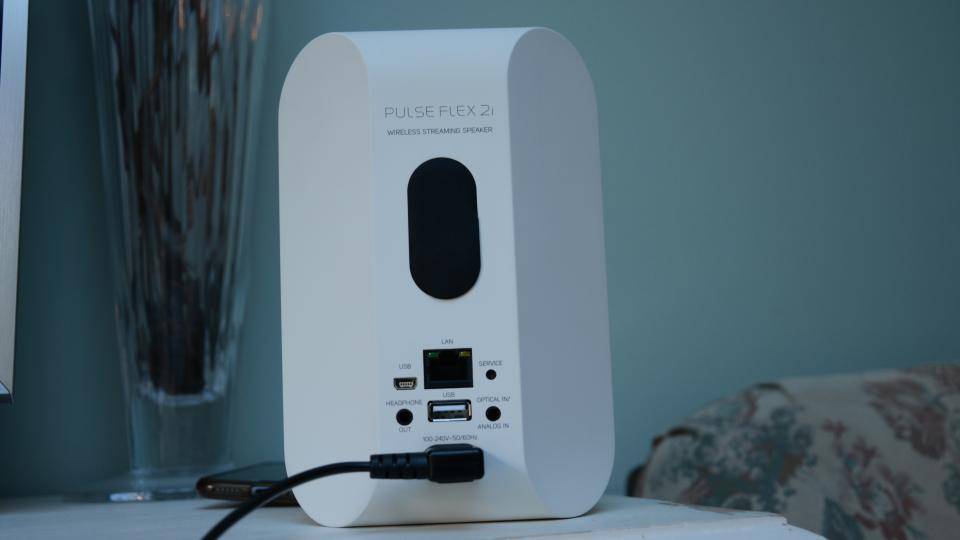The Bluesound Pulse Flex 2i is the most compact entry in Bluesound’s latest generation of Pulse wireless speakers. The range has come a long way since we reviewed the original Pulse back in 2015 and now features three speakers capable of streaming 24-bit high-resolution audio. The Flex 2i is the most budget-friendly option, with the flagship Pulse 2i offering a more comprehensive all-in-one streaming experience and the Pulse Mini 2i sitting between them in terms of power, size and price.
If you have a fast enough internet connection to take advantage of hi-res streaming services, the Pulse Flex 2i is an attractive speaker that packs a serious punch.
What do you get for the money?
For £299 you get a 125 x 100 x 183mm (WDH) wireless speaker with high-resolution audio capabilities, a range of connectivity options and support for numerous streaming services. The speaker weighs in at 1.23kg, so isn't the most lightweight option, but, given that it’s primarily a mains-powered speaker, that isn’t an issue.
The large grill on the front of the speaker is all you’ll see when looking at it head-on, which gives the Pulse Flex 2i a no-nonsense, minimalist feel. That is reinforced by the choice of colours. The speaker is only available in white or matte black; you won’t find any garish hues here.
Aside from the speaker, there isn’t much else in the box. You get 120V and 240V AC power cords, a Toslink to mini-Toslink optical adapter and that’s your lot. As mentioned above, this is a speaker designed to be connected to the mains but if you fork out an extra £69 for the Bluesound BP100 battery pack you can use it portably. It's a little heavy to lug around compared to most of the entries on our Best Bluetooth speaker list but does have the distinct advantage of being able to connect via WiFi. Should you want an additional method of controlling the speaker, Bluesound sells an IR remote that’s compatible with all of its Gen 2 and Gen 2i players.


How well connected is it?
The Bluesound Pulse Flex 2i’s main form of connectivity is Wi-Fi, specifically of the dual-band 802.11ac variety, so you’ll be mainly streaming music to it over your home network. You can also connect your devices directly to it via Bluetooth and the speaker supports the aptX codec as well as standard SBC. However, there’s no support for aptX HD, which is available on both the Pulse 2i and Pulse Mini 2i.
Located at the back of the speaker are a decent range of physical ports. There’s Ethernet for hooking up directly to your router, a 3.5mm headphone out, analogue in, USB-A for FAT32 and NTFS formatted memory sticks and a microUSB socket (for servicing only). Hidden behind a rubber bung is the connector used to attach the battery pack and a threaded socket that facilitates wall mounting with the Pulse Flex bracket .

How easy is it to set up?
In theory, the Bluesound Pulse Flex 2i is very easy to set up: download the BluOS app on either iOS and Android, connect to your Wi-Fi via the device you want to control your speaker with, and complete setting it up via the app.
In practice, though, this proved trickier than it should have been. It took a few attempts to connect the speaker to my iPhone and once the two had connected there were issues with updating the firmware – the speaker would continually get stuck in Upgrade Mode, causing it to disconnect. In the end, I had to resort to upgrading the firmware via Ethernet cable, but once I’d done this, the setup process proceeded without a hitch.
What are the app and streaming services like?
Once you’re up and running, you can set about adding your streaming services of choice to the app’s UI. There’s a long list of services to choose from, including Amazon Music HD, Deezer, Napster, QoBUZ and TIDAL. Spotify is also available, although you’ll need a premium account and can only access playlists through the Spotify app, not BluOS.
In addition to the music streaming services on offer, you can access internet radio stations through a number of third-party platforms. There’s Radio Paradise, which has four genre-specific playlists, TuneIn, which has a far more extensive selection of stations, plus a couple of services you can only access if you’re in the US.
The Bluesound Pulse Flex 2i also offers support for both Amazon Alexa and Google Assistant voice assistants though it does so indirectly. To use them, you need to go through Bluesound’s own voice control interface, Blue Voice. This requires installing a set of Alexa Skills for Blue Voice or setting up an account via Google Assistant. Voice controls work well enough but it took me a little while to retrain my brain to say “OK Google, talk to Blue Voice…” when issuing commands. If smart functionality is top of your priority, it’s worth checking out the Sonos One and Harman Kardon Citation One , both of which are cheaper options and don't require going through an intermediary interface to control vocally.
Within the BluOS app you can create playlists and presets, earmark favourite songs, artists, albums etc. and tweak the speaker’s settings. There are a pleasing amount of settings to play around with, including the option to change your output mode from stereo to left, right or mono, set a volume limit, adjust the bass and treble and activate Bluesound’s Replay-gain feature. When engaged, Replay-gain uses a track or album’s metadata to provide consistent volumes levels across said tracks or album. It’s a clever feature but not one that I felt I ever really needed to use.
The other noteworthy setting is Amplifier Standby, which powers down the amplifier after 15 minutes of inactivity. The Pulse Flex 2i doesn't have an off button and is always online so having the setting switched on comes in handy for conserving power. There is, however, a slight delay when you re-engage the speaker. It's not significant enough to cause any real irritation and is something I found I got used to pretty quickly.
It takes a little while to familiarise yourself with where things are located within the app and how to effectively manoeuvre between the various pages, particularly on a mobile device. However, once you're accustomed to the layout it's easy enough to navigate.
When you’re not using the app or remote, controls options are limited to the illuminated buttons on the top of the speaker. These control all your basic functions: play/pause music, skip tracks and volume control, while the five numbered preset buttons let you move freely between your favourite streaming channels.
How does it sound?
The Pulse Flex 2i houses a 25mm tweeter and 102mm woofer and is powered by a 25W amplifier. The result is sound that belies the diminutive stature of the speaker. At maximum volume, the Pulse Flex 2i easily fills a large room: I was taken aback by just how much volume this thing pumps out.
Sound quality is good on the whole. While listening to a couple of TIDAL’s Masters playlists, the Pulse Flex 2i did justice to the majority of the Master Quality Authenticated (MQA) tracks. Vocals and instruments on Haim’s “The Steps” were reproduced extremely cleanly and the mids and treble dominating a range of other indie ditties sounded spot-on.
Bassier tracks didn’t fare quite as well, sounding a little muddy for my tastes but dropping the bass level down a couple of notches in the EQ settings improved things. The soundstage felt rather narrow but it didn’t detract too much from what was otherwise a very enjoyable listen.
Should I buy it?
It goes without saying that if you’re buying a wireless speaker with the intention of listening to high-resolution audio, you need to make sure your Wi-Fi can handle the streaming demands put upon it.
Assuming your home has a speedy and solid connection, I’d highly recommend the Pulse Flex 2i. It has a pleasing sound signature and can deliver seriously impactful hi-res audio while providing a wide range of streaming services and connections.